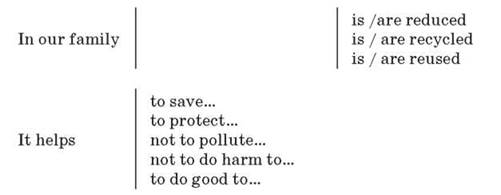|
3. Reading and writing Do Ex. 1, p. 130. Practise the new vocabulary. What can we... ...reduce? ...reuse? ...recycle? Use this words: energy, water, glass bottles, newspapers, cardboard, plastic containers, tins, cans, paper. What is reduced, reused and recycled in your family?
4. Speaking Do Ex. 2, p. 130. 5. Reading Scan the text and check your understanding with “true” or “false sentences. Litter Is a Problem in our Cities Litter is garbage - like food, paper, and cans - on the ground or in the street. Where many people live together, litter is a problem. People don't always put their garbage in the garbage can. It's easier to drop a paper than to find a garbage can for it. But litter is ugly. It makes city look dirty, and it spoils the view. The wind blows papers far away. Often they are difficult to catch. When they blow against a fence, they stay there. This fence is a wall of garbage. Litter is a health problem, too. Food and garbage bring animals, which sometimes carry disease. Some people want to control litter. They never throw litter themselves, and sometimes they work together in groups to clean up the city. In most places litter is against the law. The law punishes people who throw garbage on the streets. They usually pay a fine, and occasionally they go to jail. Two famous sayings in the United States are: “don'T be a litterbug” and “Every litter bit hurts”. Comprehension check 1) We can find litter everywhere. 2) People always put garbage in the garbage can. 3) Litter is ugly. 4) Litter spoils the view. 5) Litter isn't a health problem. 6) People want to control litter. 6. Reading and writing Do Ex. 4, 5, p. 131. 7. Summary 1) What things make your environment attractive/ unattractive? 2) What can you do to help the environment? 8. Homework Do Ex. 6, p. 131.
|
| ||||||||||||||||||||||||
